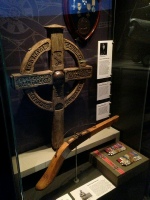On the day Richthofen was killed, 21 April 1918, Little, flying a Sopwith Camel, picked off the rear-
‘I was then attacked by six other E.A. (enemy aircraft) which drove me down through the formation below me. I spun but had my controls shot away and my machine dived. At 100ft from the ground it flattened out with a jerk, breaking the fuselage just behind my seat. I undid the belt and when the machine struck the ground I was thrown clear. The E.A. still fired at me while I was on the ground. I fired my revolver at one which came down to about 30 ft. They were driven off by rifle and machine gun fire from our troops’.
The end came on the night of 27 May 2018 when Little received reports of German Gotha bombers in the vicinity, and took off alone from Ezil le Hamel on a moonlit evening to intercept the raiders. As he closed with one of the bombers, his plane was caught in a searchlight beam and he was struck by a bullet that passed through both his thighs.  He crash-
He crash-
Little was buried in the village cemetery at Nœux, before his body was moved to Wavans British Cemetery in the Pas de Calais. His wife had these words inscribed on his headstone: ‘”Croix de Guerre with Star”/His ever loving wife/and little son Blymp. Also his loving father’.
in the village cemetery at Nœux, before his body was moved to Wavans British Cemetery in the Pas de Calais. His wife had these words inscribed on his headstone: ‘”Croix de Guerre with Star”/His ever loving wife/and little son Blymp. Also his loving father’.
The propeller blade from Little's Sopwith Triplane was fitted with a clock in its hub by his fellow officers, who presented it to his widow; she transported it back to Australia in three pieces and it later went on display at the Australian War Memorial, along with his awards and the wooden cross of his original burial place at Nœux. One of the buildings of the Australian Defence Force Academy (ADFA) in Canberra, opened in 1986, was named in Little's honour.



Robert Alexander Little -






